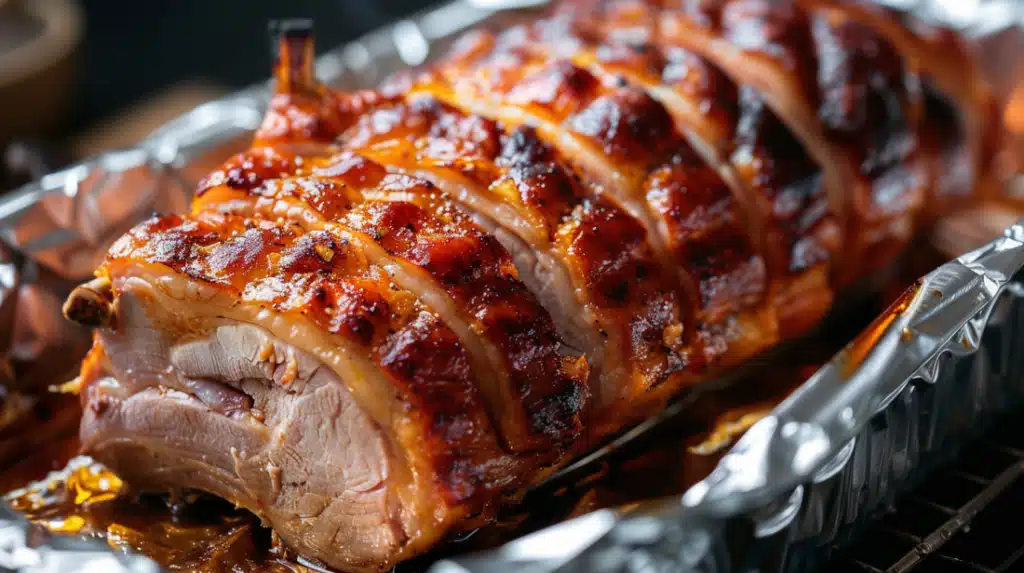Are you unsure how long your cooked pork will last in the fridge? You’re not alone.
Many home cooks struggle with knowing when their leftovers have gone bad, leading to wasted food and money.
But fear not! This article clarifies the confusion and provides simple guidelines for safely storing cooked pork.
You’ll learn how long to keep your pork dishes in the refrigerator without risking foodborne illness and tips for proper storage and reheating.
Say goodbye to the guesswork and hello to confidently enjoying your delicious pork leftovers. Read on to master the art of storing cooked pork in your fridge.
General Guidelines for Pork Storage
| Type of Pork | Refrigerator (40°F) | Freezer (0°F) |
|---|---|---|
| Raw Pork: | ||
| Roast, chops, or ribs | 3-5 Days | 4-6 Months |
| Ground pork, liver, or a variety of meats | 1-2 Days | 3-4 Months |
| Uncured Ham | 3-5 Days | 4-6 Months |
| Cured Ham | 5-7 Days | 3-4 Months |
| Cooked Pork: | ||
| Roast, chops, casseroles | 3-4 Days | 2-3 Months |
| Ground pork; store-cooked convenience meals | 1-2 Days | 2-3 Months |
| Uncured Ham | 3-4 Days | 3-4 Months |
| Cured Ham | 3-5 Days | 1-2 Months |
Proper pork storage is essential to prevent foodborne illnesses and ensure food safety.
Following these guidelines can help keep your cooked pork dishes fresh and safe to eat, reducing the risk of health issues caused by harmful bacteria.
1. USDA and FDA Storage Recommendations
The United States Department of Agriculture (USDA) and the Food and Drug Administration (FDA) are trusted sources for food safety information.
According to their guidelines, cooked pork should be eaten or frozen within 3-4 days when stored in the refrigerator at or below 40°F (4°C). Maintaining this temperature is crucial to slow down bacterial growth, which can lead to food spoilage and potential health risks.
2. The 2-Hour Rule
In addition to refrigeration, cooked pork should not be left at room temperature for more than 2 hours.
If the room temperature is above 90°F (32°C), this timeframe is reduced to just 1 hour. Bacteria multiply quickly in warm environments, so it’s essential to be mindful of how long your cooked pork has been sitting out.
3. Practical Tips for Implementation
To implement these guidelines, always refrigerate your pork leftovers as soon as possible to avoid the “temperature danger zone” where bacteria thrive.
Use airtight containers or wrap the pork tightly in plastic wrap or aluminum foil to protect it from air exposure and prevent cross-contamination with other foods in the fridge.
Remember, improper storage of cooked pork can lead to serious health risks.
Following these simple guidelines can significantly reduce the chances of foodborne illnesses.
To ensure your refrigerator maintains a consistent, safe temperature, check its settings with an appliance thermometer and adjust as needed.
Mastering the Art of Storing Cooked Pork

1. Proper Refrigeration: The Key to Safe Pork Storage
Immediate refrigeration after cooking prevents bacterial growth on your pork dishes.
Once your pork has cooled to room temperature, please place it in the refrigerator within 2 hours. If the room temperature is above 90°F (32°C), reduce this time to 1 hour.
2. Airtight Containers and Wrapping Techniques
To minimize air exposure and prevent spoilage, use airtight containers or wrap your pork tightly in aluminum foil or plastic wrap. Press the wrap firmly against the surface of the pork to ensure that no part of the meat is exposed to air.
If using containers, choose ones with tight-fitting lids and avoid overfilling to allow for proper air circulation.
3. Maintaining the Optimal Fridge Temperature
Your refrigerator should be at 40°F (4°C) or below to slow bacterial growth effectively.
Use a refrigerator thermometer to monitor the temperature regularly, placing it in the warmest part of the fridge, usually near the door.
To maintain a stable temperature, avoid frequent door openings and ensure the fridge is not overloaded, allowing cold air to circulate freely.
Risks of Improper Storage

Health Hazards: Foodborne Illnesses
Improperly stored pork can lead to the growth of harmful bacteria such as salmonella, E. coli, and listeria, which can cause food poisoning.
Symptoms may include nausea, vomiting, diarrhea, fever, and abdominal cramps.
In severe cases, foodborne illnesses can lead to hospitalization or even death, especially for vulnerable populations like children, the elderly, and those with weakened immune systems.
Spotting Signs of Spoilage
Spoiled pork may exhibit the following signs:
- Discoloration: The meat may appear grayish, greenish, or have dark spots.
- Slimy texture: The surface of the pork may feel slimy or sticky to the touch.
- Unpleasant odor: Spoiled pork may smell sour, sulfuric, or ammonia.
If you notice these signs, discard the pork immediately to prevent cross-contamination with other foods in your fridge. Wrap the spoiled meat securely in plastic bags before disposing it in a sealed trash container.
The Benefits of Proper Cooked Pork Storage

1. Protecting Your Health
Following proper storage guidelines significantly reduces the risk of contracting foodborne illnesses.
Studies have shown that implementing safe food handling and storage practices can decrease the incidence of food poisoning by up to 70%.
2. Saving Money and Reducing Food Waste
Proper storage extends the shelf life of your cooked pork, allowing you to enjoy leftovers safely for up to 4 days.
This can lead to significant cost savings over time by reducing food waste.
For example, if a family of four discards 1 pound of cooked pork per week due to improper storage, they could be wasting up to $200 per year, based on an average price of $4 per pound.
3. Preserving Flavor and Quality
Storing your pork correctly helps maintain its delicious flavor, tender texture, and nutritional value.
For best results, consume refrigerated pork within 3-4 days. If you plan to keep it longer, consider freezing the meat in airtight containers or freezer bags for up to 2-3 months.
Proper storage ensures your pork dishes taste as good as the day you cooked them.
Maximizing Shelf Life: Freezing Cooked Pork

The shaded red area highlights the critical temperatures between 40°F and 140°F, where bacterial growth is most rapid and hazardous.
Temperatures below 40°F and above 140°F are considered safer, as indicated by the lower risk of bacterial growth.
1. The Benefits of Freezing
Freezing cooked pork is an excellent way to extend its shelf life and minimize food waste.
By storing pork in the freezer, you can safely keep it for 2-3 months, allowing you to enjoy your leftovers later. This is particularly useful when you have cooked a large amount of pork and want to save some for future meals.
2. Proper Wrapping Techniques for Freezer Storage
To prevent freezer burn and maintain the quality of your cooked pork, it’s essential to wrap it properly before freezing. Follow these steps:
- Choose the right packaging materials: For long-term storage, use heavy-duty aluminum foil, freezer paper, or freezer bags.
- Remove excess air: If using freezer bags, press out as much air as possible before sealing to minimize exposure to air, which can cause freezer burn.
- Label and date: Mark your packages with the type of pork and the date you froze it. This will help you keep track of your frozen pork and ensure you use the oldest packages first.
3. Shelf Life and Thawing Methods
Cooked pork can be safely stored in the freezer for 2-3 months.
When ready to use your frozen pork, thaw it in the refrigerator overnight or use the defrost setting on your microwave for quicker thawing.
Never thaw pork at room temperature, as this can promote bacterial growth. Once melted, reheat the pork using the above methods, ensuring it reaches an internal temperature of 165°F (74°C) before consuming.
Reheating Cooked Pork: Ensuring Safety and Quality
1. The Importance of Safe Reheating
Reheating cooked pork safely is crucial to prevent the growth of harmful bacteria that may have developed during storage.
To ensure its safety, pork must maintain an internal temperature of 165°F (74°C).
This temperature kills any potential bacteria, minimizing the risk of foodborne illnesses.
2. Using a Food Thermometer
Always use a food thermometer when reheating to guarantee your pork has reached the safe internal temperature of 165°F (74°C).
Insert the thermometer into the thickest part of the meat, avoiding contact with any bones, as they can give false readings. For accurate results, check the temperature in several places.
3. Reheating Methods for Different Pork Cuts
| Pork Cut | Reheating Method | Instructions | Temperature and Time |
|---|---|---|---|
| Roasts | Oven | Preheat your oven to 325°F (165°C). Cover the roast in an oven-safe dish with foil to retain moisture. | Heat until the internal temperature reaches 165°F (74°C). Depending on the size of the roast, this typically takes 20-30 minutes per pound. |
| Chops | Oven | Follow the same method as for roasts. | Heat until the internal temperature reaches 165°F (74°C). |
| Stovetop | Place the chops in a skillet over medium heat. Cover the skillet with a small amount of broth, water, or other liquid. | Heat until the internal temperature reaches 165°F (74°C). | |
| Ground Pork | Stovetop | Place ground pork in a skillet over medium heat. Stir frequently to ensure even heating and to break up any clumps. | Continue heating until the pork reaches 165°F (74°C) throughout. |
Conclusion
Proper storage and reheating techniques are essential for ensuring your cooked pork remains safe to eat and retains its flavor.
Following the guidelines outlined in this article, you can confidently store your pork dishes in the refrigerator for up to 4 days or in the freezer for 2-3 months.
Always use a food thermometer when reheating to guarantee your pork reaches a safe internal temperature of 165°F (74°C).
Implementing these simple yet effective strategies protects your health, helps minimize food waste, and saves you money in the long run.
So, the next time you have leftover pork, feel empowered to store and reheat it properly, knowing you prioritize safety and quality.
Frequently Asked Questions
Can Pork Be in The Fridge for A Week?
No, cooked pork should only be refrigerated for 3-4 days. After that, it’s best to freeze it for longer storage.
Can I Eat Cooked Pork After 7 Days?
Eating cooked pork after 7 days, even if refrigerated, is not recommended. The risk of foodborne illness increases after 4 days.
How Do You Tell if Pork Has Gone Bad?
Signs of spoiled pork include a sour or off odor, slimy or sticky texture, and grayish or greenish discoloration. If you notice any of these, discard the pork.




